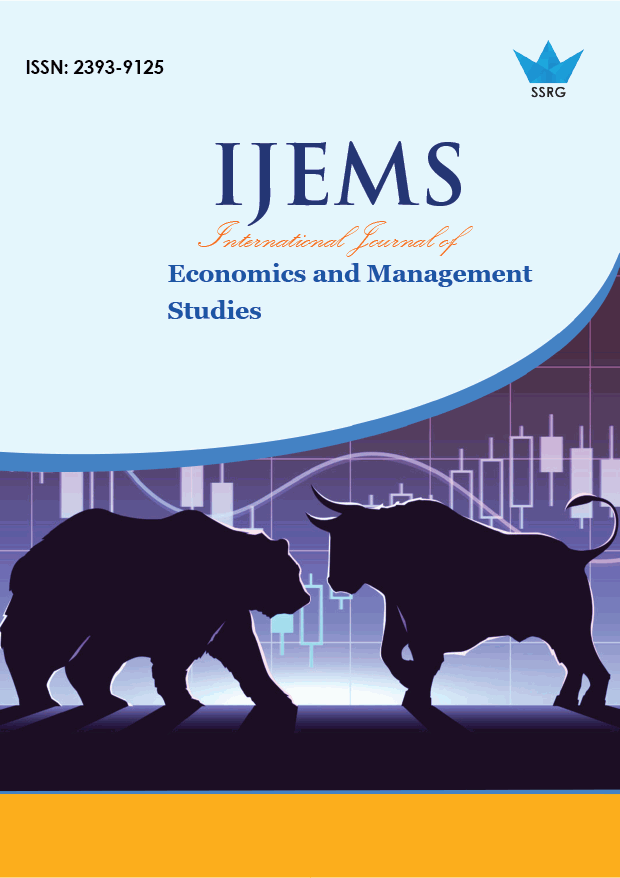Impact of Food Subsidy on Socio-Economic Status of Odisha

| International Journal of Economics and Management Studies |
| © 2019 by SSRG - IJEMS Journal |
| Volume 6 Issue 10 |
| Year of Publication : 2019 |
| Authors : Pranjali Das,Gouri Prava Samal |
How to Cite?
Pranjali Das,Gouri Prava Samal, "Impact of Food Subsidy on Socio-Economic Status of Odisha," SSRG International Journal of Economics and Management Studies, vol. 6, no. 10, pp. 120-123, 2019. Crossref, https://doi.org/10.14445/23939125/IJEMS-V6I10P116
Abstract:
Odisha, being one of the top FDI destinations of India, is still regarded as one of the poorest state of the country. Odisha is far behind its country across
many developmental aspects. The problem is basically from two aspects, i.e., Social and Economic. To check these problems for the sake of socio-economic upliftment, various types of subsidies are being provided in various sectors by the government from time to time. From the various types of subsidies, Food Subsidy(FS) has a major contribution, which accounts for 41.58 percent of total subsidy on an average. The present paper is an attempt to highlight the socio-economic problems of the state and the contribution of Food Subsidy to minimize them. It also analyses the relationship between Food Subsidy and socio-economic status of Odisha on the basis of certain parameters such as State Gross Domestic Product (SGDP), Per Capita Income (PCI), Human Development Index (HDI) and Unemployment Rate (UR). Various statistical tools like Multiple Correlation and Linear Regression has been applied to analyse the data collected from the secondary sources. The paper concludes that there is no significant relationship as well as significant impact of Food Subsidy with the socio-economic parameters, taken under the present study except HDI. The present attempt will be helpful for the government as well as the policy makers regarding formulation of food subsidy policies.
Keywords:
Socio-economic problems, SGDP, PCI, HDI, UR, Food Subsidy
References:
[1] Acharya,A. (2015). Socio-Cultural Constraints of Economic Development In Rural Odisha. Shodhganga.
[2] Adams, J., Weakliem, D. (2011). Four Factor Index of Social Status. Yale Journal of Sociology, 8.
[3] Altavilla,C. (2012). The Implications of Reforming Agricultural Input-Subsidies for More Holistic Rural Development: A Case Study of Punjab. Proquest LLC, UMI1530096.
[4] Amar, Anil (2014). Public distribution system in miraj Tahsil with special reference to direct subsidy for below poverty line card holders. Shodhganga.
[5] Angappapillai, A. and Sobana, V. (2013). An analysis of Socio Economic Status and access to Public Health in Coimbatore district in Tamilnadu. International Journal of Management Research and Review, 3: 2249-7196, 2185-2203.
[6] Bagchi, D. (2001). Production and Export Subsidies: A Dynamic Analysis. Shodhganga.
[7] Buoga, I. (2016). Effects of input subsidies on diversification of food production in Malawi. Proquest.
[8] Chandrashekar, T. (2006). Fertilizer Subsidies And Its Implications On Central Budget-India. Shodhganga.
[9] Chinnamai,N. (1997). Food subsidy and its impact on public distribution systems. Shodhganga.
[10] Disodia,V. (2007). A study of implementation of urban poverty alleviation programmes in haryana. Shodhganga.
[11] Gangadhara,B. (2010). An evauation of the impact of fisheries subsidy on fishery resources, marketing and trade in the coastal mangalore taluk: a case study. Shodhganga.
[12] Gharibnavaz,M. (2013). A General Equilibrium Analysis of Alternative Scenarios for Food and Energy Subsidy Reforms
in Iran. Proquest.
[13] Hemming, D., Chirwa, E., Dorward, A., Ruffhead, H., Hill, R., Osborn, J., Langer, L., Harman, L., Asaoka, H., Coffey, C. and Phillips, D. (2018). Agricultural input subsidies for improving productivity, farm income, consumer welfare and wider growth in low- and lower-middle-income countries: a
systematic review, International Development Coordinating Group.
[14] Jim, M. and Mariano, M. (2014). The Economic Effects And Food Security Impact Of Philippine Rice Market Interventions. Proquest.
[15] Kaur, R. (2012). Agriculture Subsidies In Punjab: An Analysis. Shodhganga.
[16] Kumar, B. (2015). Law Relating To Food Security In India: Problems And Issues. Shodhganga.
[17] Lenka, S. (2009). Implications of development programmes on the socio-economic status of tribals -a case study of koraput district, Orissa. Shodhganga.
[18] Lundberg, J. (2012). An Analysis of the Impacts of Electricity Subsidy Removal on Subsistence Rice Farmers in Tamil Nadu, India. Proquest.
[19] Mahfouz, R. and Ramzy, Y. (2014). The Impact of new governmental food subsidies strategy on customer’s current economic conditions. The Business and Management Review, 5: 87-99.
[20] Mishra, L. (1999). Volume and composition of subsidies in Orissa. Shodhganga.
[21] Moorthi, G. (2014). A Study of Public Distribution System In Madurai District. Shodhganga.
[22] Panda, S. (2004). Socio-economic history of Orissa, 1947-1967. Shodhganga.
[23] Prahutama, A. and Mukid, A. (2015). Analysis of food subsidy using Kernel Discriminant. 5th International Seminar on ISSN: 978-602-71169-7-9 New Paradigm and Innovation on Natural Sciences and Its Application (5th ISNPINSA), ISSN: 978-602-71169-7-9.
[24] Reddy, P. (2002). Role Of Public Distribution System In The Economic Development Of Trlbals In Prakasam And Nellore Districts Of Andhra Pradesh. Shodhganga.
[25] Sharma,V. and Alagh,M. (2013). Food Subsidy in India: Its Components, Trends, Causes and Reforms for Public Policy. Indian Journal of Agricultural Economics, 68 : 195.
[26] Thangam, A. (2014). Impact of subsidies on agricultural production in tamil nadu with special *reference to kanyakumari district. Shodhganga.

 10.14445/23939125/IJEMS-V6I10P116
10.14445/23939125/IJEMS-V6I10P116